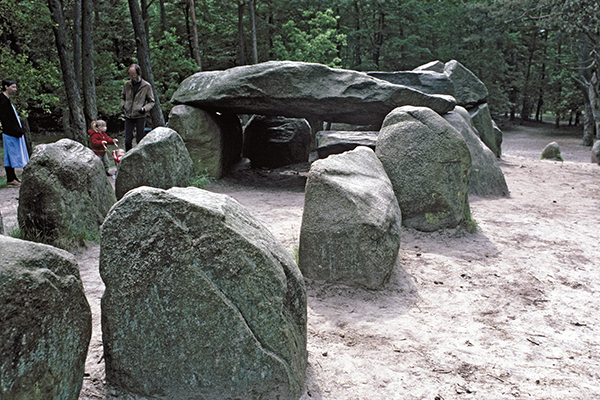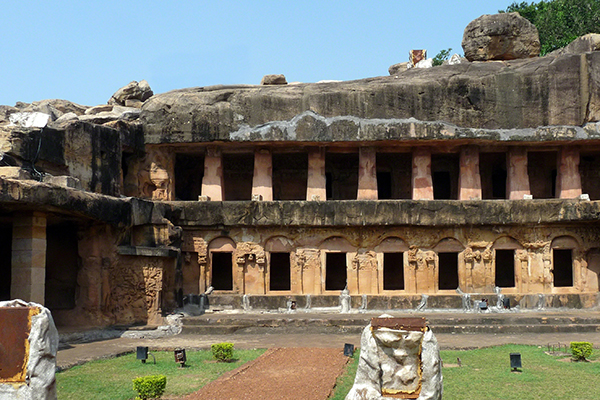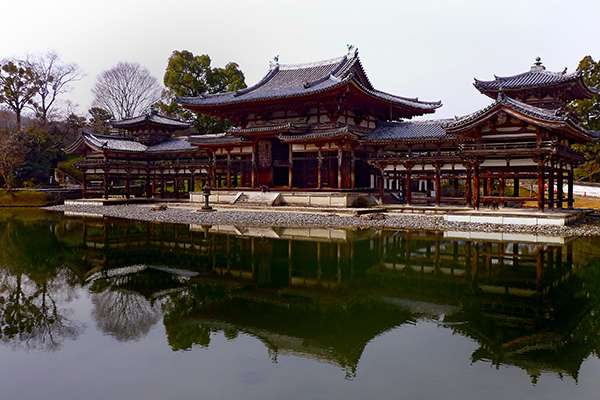Do Not Deface! Historic Sites to Visit Respectfully
As an art historian and artist, I am appalled by recent incidents of tourists defacing the Colosseum (72–80 CE) in Rome and Toshodai-ji (founded 759 CE) in Nara, Japan, with their initials. It is really beside the point if these tourists “didn’t know how old they were.” And I refuse to call their defacing “graffiti,” because these people are not artists, nor was it blank city walls or canvas. It was narcissism pure and simple, and a sign of an overall lack of respect for other cultures that seems to dominate tourism these days. In order to put on a happy face, let’s look at some interesting old structures that I’m hoping haven’t suffered any “tourist signings” (fingers crossed), and that you may never have seen before.
 |
| Funnelbeaker Culture (flourished ca. 4300–2800 BCE), Hunebed (D45 Emmen), Emmerdennen, Netherlands, ca. 3000–1500 BCE. Image © 2023 Davis Art Images. (8S-28460) |
Hunebeds are prehistoric burial chambers. Originally, hunebeds consisted of a series of "doors" formed by two upright massive stones and one massive stone laid across the top (dolmen), a sort of prehistoric post-and-lintel construction. Two doors placed one behind the other formed a tunnel-like entrance to the burial chamber in the middle. It was sometimes surrounded by a circle of massive stones (megaliths). The structure was then covered with earth to form a mound (cairn).
The hunebed near Emmen, D45, still has six of its nine original capstones, though some have fallen off the support stones. Like many hunebeds, the largest stone at Emmen is on the west side, possibly because the setting sun symbolized death to the Funnelbeaker builders. The boulders used to build the hunebed are thought to have come from Sweden and Finland 150,000 years ago, carried by glacier movement during the Ice Age. The largest hunebed stones are around 40 tons. The Emmen hunebed is about 60' 8 1/4" (18.5 meters) long.
During the last Ice Age, which ended around 22,000 BCE in Europe, the Netherlands had a tundra type of environment (flat, treeless, Arctic-like region with frozen soil). The people were hunter-gatherers. By the end of the Paleolithic Period (ca. 8000 BCE), various groups inhabited northern Netherlands and produced the earliest known version of a canoe, establishing winter and summer hunting camps.
The Funnelbeaker culture—a farming culture that introduced grains to the region and extended from Denmark into Northern Germany and Northern Netherlands—began to flourish in the Netherlands in the late 4000s BCE. Archeologists coined the term "Funnelbeaker" for the culture because of the distinctive shape of their pottery found near hunebed burial sites. During this period of Dutch prehistory, the first monumental structures were erected, notably the large stone grave monuments called hunebeds.
 |
| India, Bhuvaneshvara, Rani Gumpha, Udayagiri Rock-Cut Temples, ca. 193–170 BCE. Photo: Steve Browne and John Verkleir. CC-BY-SA 2.0. (8S-10198) |
The city of Bhuvaneshvara (Bhubaneswar) has been considered a holy site for more than two thousand years. The city first arose to prominence in the 300s BCE. Udayagiri (“Sunrise Hill”) Caves to the south of Bhuvaneshvara give evidence of Jain and Buddhist religions in the last two hundred years BCE. Many of the rock-cut places of worship there were repurposed as Hindu religious sites.
Udayagiri Caves are part of what became Kalinga, a historic region of east-central India that including parts of Andhra Pradesh and Odisha states. This area flourished under the Eastern Ganga dynasty (498–1436) from the 1000s until the 1300s, when the Delhi Sultanate (1206–1526) conquered the region. It was during the Eastern Ganga dynasty that the most spectacular temples were built.
The Bhuvaneshvara region was under the influence of Jainism when the Udayagiri Caves were developed. During the reign of Kharavela (193 BCE–170 BCE), living spaces for Jain monks were carved into the rocks to make eighteen natural and human-made caves. The largest cave, Rani Gumpha (“Cave of the Queen”), is a two-story space with a central room and two wings on each floor. The cave features relief carvings and sculptures of animals, vegetation, and people. Unlike the rock-cut temples of Mahamallapuram, the Udayagiri Cave temples are not free-standing.
 |
| Heian Period, Japan, Byodo-in, Uji, 1052–1053. Photo: Oilstreet. CC BY-SA 3.0. (8S-30007) |
The Byodo-in temple in Uji, Japan (south of Kyoto), is the most elaborate existing example of Heian period (794–1185) architecture. Over the years, members of different Buddhist sects have worked to maintain the temple, including the Tendai of Buddha Sakyamuni, the historical Buddha; the Shingon of Buddha Vairocana, the primordial Buddha; and the Jodo of Amitabha, Buddha of the Western Paradise or Pure Land. Today, the Tendai and Jodo sects have temples at Byodo-in. It was built out of the villa of Fujiwara no Yorimichi (992–1074), the chief adviser to the emperor. In subsequent centuries, the practice of rulers or nobles donating their villas to be converted into monasteries was quite common.
The main building of Byodo-in, called Phoenix Hall (Hou-ou-do Hall or Amida Hall), is composed of a central hall and two wings. The flared roof eaves and prominent post and lintel construction are typical of Chinese architecture. It is called Phoenix Hall for the two gilt mythological bird figures on each end of the central hall roof. They were the Chinese symbol for the empress. At Byodo-in, they may have referred to the many empress-daughters of the Fujiwara clan, which eventually led the Fujiwara to control the late Heian period. The layout of the temple is designed so that visitors can bow from the east side of the pond toward the Western Paradise, or Pure Land in the west. The pond represents the pool in the Western Paradise above which the Buddha sits on a lotus throne.
Historically, Japanese architecture took its cues from China. There were some modifications that provided a unique Japanese flavor. While Chinese wooden temples were painted in bright colors, the Japanese preferred the muted, natural appearance of wood. The arrival of Buddhism (500s CE) had a significant impact on Japanese ritual architecture. During the Nara period (645–794 CE), Japanese architects adapted the Chinese idea of symmetrical layout and north-south orientation facing south.
The Heian period was an era of refined imperial court culture dedicated to beauty in painting, poetry, literature, and architecture. The first important novel in world literature, The Tale of Genji, appeared during the Heian era. It was a combination of poetry and prose by a woman now known as Murasaki Shikibu. The Heian period also saw the rise of provincial military clans organized in a feudal system. These clans continually challenged the emperor’s power and insisted that Japan reject the overwhelming amount of Chinese influence on Japanese culture.
New types of Buddhism extended into Japan from China during the Heian period, notably the Shingon and Tendai sects, both of which were esoteric, emphasizing mystery and secrecy. The esoteric sects had an impact on Heian architecture, preferring mountain retreats, unlike earlier temple architecture that was open to laity and clergy alike. Another trait of Heian temples of the esoteric sects was asymmetrical plans, due to the irregularities of remote sites.
In contrast to the esoteric sects was Pure Land (Jodo) Buddhism, which also took hold in Japan during the Heian Period, eventually becoming the most popular sect. Pure Land Buddhism was open to everyone with the simple requirement of worshipping the Amitabha, the Buddha of the Western Paradise.
Correlations to Davis programs: Explorations in Art 2E Grade 1: 2.8; Explorations in Art 2E Grade 2: 6.1, 6.2, 6.4; Explorations in Art 2E Grade 3: 4.2, 4.4; Explorations in Art 2E Grade 5: 2.8; Explorations in Art 2E Grade 6: 4.1, 4.2; Experience Art: 5.3; A Personal Journey 2E: 8.1


Comments